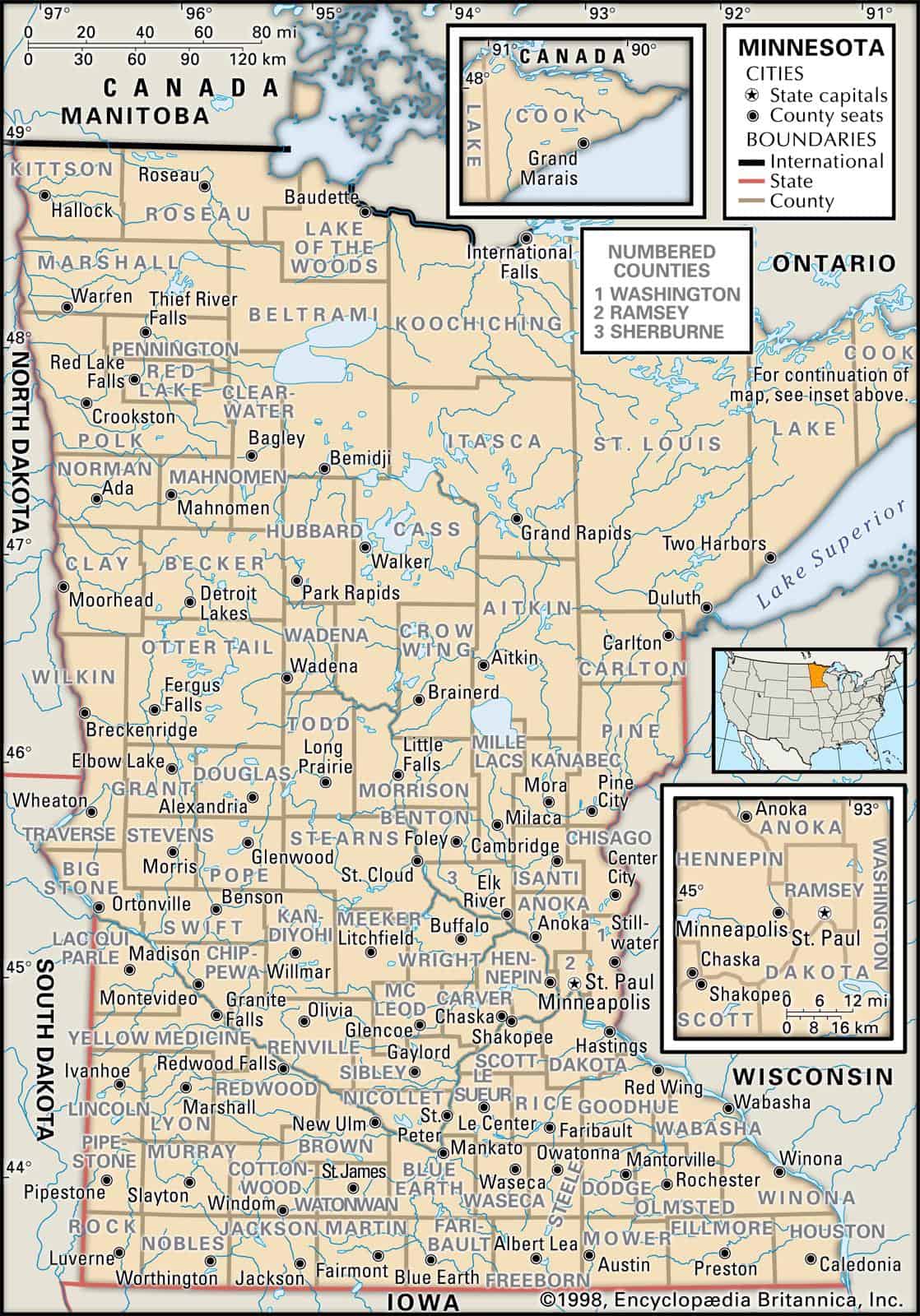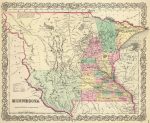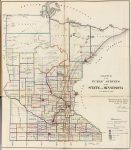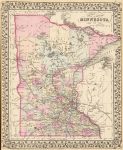
Maps of Minnesota are a vital area of genealogy and family history research, particularly if you live far away from where your ancestor was living.
Due to the fact that Minnesota’s political boundaries have often changed over the years, historic maps are important in helping you find out the exact location of your ancestor’s home, what land they owned, just who their neighbors were, and much more besides.
Maps of Minnesota are an outstanding resource for getting started with your own research because they provide important information and facts immediately, and then present them in a clear and understandable manner.
The 10 largest cities in Minnesota are Minneapolis, St. Paul, Rochester, Duluth, Bloomington, Brooklyn Park, Plymouth, St. Cloud, Eagan, and Woodbury.
Learn more historical facts about Minnesota counties here.
Interactive Map of Minnesota County Formation History
AniMap Plus 3.0, with the permission of the Goldbug Company
List of Every Minnesota County
Aitkin County
Aitkin County was established in 1857 and has a population of around 15,000 people. It is located in central Minnesota and is known for its beautiful lakes and forests.
Anoka County
Anoka County was established in 1857 and is located in the northern part of the Twin Cities metropolitan area. It has a population of around 350,000 people and is home to the city of Anoka, which hosts the annual Halloween Capital of the World celebration.
Becker County
Becker County was established in 1858 and is located in northwestern Minnesota. It has a population of around 34,000 people and is known for its recreational opportunities, including numerous lakes and trails.
Beltrami County
Beltrami County was established in 1866 and is located in northern Minnesota. It has a population of around 47,000 people and is home to the city of Bemidji, which is known for its Paul Bunyan and Babe the Blue Ox statues.
Benton County
Benton County was established in 1849 and is located in central Minnesota. It has a population of around 42,000 people and is known for its agricultural heritage and scenic beauty.
Big Stone County
Big Stone County was established in 1862 and is located in western Minnesota. It has a population of around 5,000 people and is known for its natural beauty, including Big Stone Lake and the nearby Ortonville Wildlife Refuge.
Blue Earth County
Blue Earth County was established in 1853 and is located in southern Minnesota. It has a population of around 67,000 people and is home to the city of Mankato, which is the largest city in the region.
Brown County
Brown County was established in 1855 and is located in southern Minnesota. It has a population of around 25,000 people and is known for its German heritage and the Hermann Monument, which commemorates the Germanic hero Arminius.
Carlton County
Carlton County was established in 1857 and is located in northeastern Minnesota. It has a population of around 36,000 people and is known for its scenic beauty, including the Superior National Forest and the St. Louis River.
Carver County
Carver County was established in 1855 and is located in the southwestern part of the Twin Cities metropolitan area. It has a population of around 110,000 people and is known for its natural beauty, including the Minnesota River and Lake Waconia.
Cass County
Cass County was established in 1851 and is located in north-central Minnesota. It has a population of around 29,000 people and is known for its recreational opportunities, including numerous lakes and trails.
Chippewa County
Chippewa County was established in 1862 and is located in western Minnesota. It has a population of around 12,000 people and is known for its agricultural heritage and the Lac qui Parle State Park.
Chisago County
Chisago County was established in 1851 and is located in eastern Minnesota. It has a population of around 57,000 people and is known for its natural beauty, including the St. Croix River and the Interstate State Park.
Clay County
Clay County was established in 1858 and is located in western Minnesota. It has a population of around 64,000 people and is home to the city of Moorhead, which is located on the border with North Dakota.
Clearwater County
Clearwater County was established in 1902 and is located in north-central Minnesota. It has a population of around 8,800 people and is known for its natural beauty, including the Itasca State Park and the Mississippi Headwaters.
Cook County
Cook County was established in 1874 and is located in northeastern Minnesota. It has a population of around 5,000 people and is known for its scenic beauty, including the Boundary Waters Canoe Area Wilderness and the North Shore of Lake Superior.
Cottonwood County
Cottonwood County was established in 1857 and is located in southwestern Minnesota. It has a population of around 11,000 people and is known for its agricultural heritage and the Lake Shetek State Park.
Crow Wing County
Crow Wing County was established in 1857 and is located in central Minnesota. It has a population of around 64,000 people and is known for its recreational opportunities, including numerous lakes and trails.
Dakota County
Dakota County was established in 1849 and is located in the southern part of the Twin Cities metropolitan area. It has a population of around 430,000 people and is home to the cities of Apple Valley, Eagan, Burnsville, and Lakeville.
Dodge County
Dodge County was established in 1855 and is located in southeastern Minnesota. It has a population of around 21,000 people and is known for its agricultural heritage and the Whitewater State Park.
Douglas County
Douglas County was established in 1858 and is located in western Minnesota. It has a population of around 38,000 people and is known for its scenic beauty, including the Lake Carlos State Park and the Chippewa River.
Faribault County
Faribault County was established in 1855 and is located in southern Minnesota. It has a population of around 13,000 people and is known for its agricultural heritage and the Riverside Town & Country Club.
Fillmore County
Fillmore County was established in 1853 and is located in southeastern Minnesota. It has a population of around 21,000 people and is known for its scenic beauty, including the Root River State Trail and the Whitewater State Park.
Freeborn County
Freeborn County was established in 1855 and is located in southern Minnesota. It has a population of around 30,000 people and is known for its agricultural heritage and the Myre-Big Island State Park.
Goodhue County
Goodhue County was established in 1853 and is located in southeastern Minnesota. It has a population of around 46,000 people and is known for its natural beauty, including the Cannon River and the Hay Creek Valley.
Grant County
Grant County was established in 1868 and is located in western Minnesota. It has a population of around 6,000 people and is known for its agricultural heritage and the Pomme de Terre State Park.
Hennepin County
Hennepin County was established in 1852 and is located in the eastern part of the Twin Cities metropolitan area. It has a population of around 1.2 million people and is home to the cities of Minneapolis and Bloomington.
Houston County
Houston County was established in 1854 and is located in southeastern Minnesota. It has a population of around 19,000 people and is known for its natural beauty, including the Root River and the Great River Bluffs State Park.
Hubbard County
Hubbard County was established in 1883 and is located in north-central Minnesota. It has a population of around 21,000 people and is known for its recreational opportunities, including numerous lakes and trails.
Isanti County
Isanti County was established in 1857 and is located in the northern part of the Twin Cities metropolitan area. It has a population of around 40,000 people and is known for its natural beauty, including the Rum River and the Isanti County Fair.
Itasca County
Itasca County was established in 1849 and is located in north-central Minnesota. It has a population of around 45,000 people and is known for its natural beauty, including the Chippewa National Forest and the Itasca State Park.
Jackson County
Jackson County was established in 1857 and is located in southwestern Minnesota. It has a population of around 10,000 people and is known for its agricultural heritage and the Des Moines River Valley.
Kanabec County
Kanabec County was established in 1858 and is located in east-central Minnesota. It has a population of around 16,000 people and is known for its recreational opportunities, including the Mille Lacs Kathio State Park and the Snake River.
Kandiyohi County
Kandiyohi County was established in 1858 and is located in southwestern Minnesota. It has a population of around 43,000 people and is known for its agricultural heritage and the Sibley State Park.
Kittson County
Kittson County was established in 1878 and is located in northwestern Minnesota. It has a population of around 4,500 people and is known for its natural beauty, including the Red River and the Lake Bronson State Park.
Koochiching County
Koochiching County was established in 1906 and is located in northern Minnesota. It has a population of around 12,000 people and is known for its natural beauty, including the Rainy River and the Voyageurs National Park.
Lac qui Parle County
Lac qui Parle County was established in 1871 and is located in southwestern Minnesota. It has a population of around 7,000 people and is known for its agricultural heritage and the Lac qui Parle State Park.
Lake County
Lake County was established in 1856 and is located in northeastern Minnesota. It has a population of around 11,000 people and is known for its scenic beauty, including the Superior National Forest and the Split Rock Lighthouse.
Lake of the Woods County
Lake of the Woods County was established in 1922 and is located in northern Minnesota. It has a population of around 3,800 people and is known for its natural beauty, including the Lake of the Woods and the Zippel Bay State Park.
Le Sueur County
Le Sueur County was established in 1853 and is located in south-central Minnesota. It has a population of around 29,000 people and is known for its agricultural heritage and the Minnesota Valley State Recreation Area.
Lincoln County
Lincoln County was established in 1873 and is located in southwestern Minnesota. It has a population of around 5,700 people and is known for its agricultural heritage and the Lake Benton Opera House.
Lyon County
Lyon County was established in 1868 and is located in southwestern Minnesota. It has a population of around 33,000 people and is known for its agricultural heritage and the Camden State Park.
McLeod County
McLeod County was established in 1856 and is located in south-central Minnesota. It has a population of around 36,000 people and is known for its agricultural heritage and the Crow River.
Mahnomen County
Mahnomen County was established in 1906 and is located in northwestern Minnesota. It has a population of around 5,500 people and is known for its natural beauty, including the Wild Rice River and the White Earth State Forest.
Marshall County
Marshall County was established in 1879 and is located in northwestern Minnesota. It has a population of around 9,400 people and is known for its natural beauty, including the Agassiz National Wildlife Refuge and the Old Mill State Park.
Martin County
Martin County was established in 1857 and is located in south-central Minnesota. It has a population of around 20,000 people and is known for its agricultural heritage and the Fairmont Opera House.
Meeker County
Meeker County was established in 1856 and is located in south-central Minnesota. It has a population of around 23,000 people and is known for its agricultural heritage and the Luce Line State Trail.
Mille Lacs County
Mille Lacs County was established in 1857 and is located in east-central Minnesota. It has a population of around 26,000 people and is known for its natural beauty, including the Mille Lacs Lake and the Father Hennepin State Park.
Morrison County
Morrison County was established in 1856 and is located in central Minnesota. It has a population of around 34,000 people and is known for its natural beauty, including the Mississippi River and the Charles A. Lindbergh State Park.
Mower County
Mower County was established in 1855 and is located in southeastern Minnesota. It has a population of around 40,000 people and is known for its agricultural heritage and the Hormel Historic Home.
Murray County
Murray County was established in 1857 and is located in southwestern Minnesota. It has a population of around 8,000 people and is known for its natural beauty, including the Lake Shetek State Park and the Murray County Fair.
Nicollet County
Nicollet County was established in 1853 and is located in south-central Minnesota. It has a population of around 34,000 people and is known for its natural beauty, including the Minnesota River and the Traverse des Sioux State Park.
Nobles County
Nobles County was established in 1857 and is located in southwestern Minnesota. It has a population of around 22,000 people and is known for its agricultural heritage and the Nobles County Pioneer Village.
Norman County
Norman County was established in 1881 and is located in northwestern Minnesota. It has a population of around 6,500 people and is known for its natural beauty, including the Wild Rice River and the Agassiz National Wildlife Refuge.
Olmsted County
Olmsted County was established in 1855 and is located in southeastern Minnesota. It has a population of around 160,000 people and is known for its urban center, Rochester, which is home to the renowned Mayo Clinic and the Chateau Theatre.
Otter Tail County
Otter Tail County was established in 1858 and is located in western Minnesota. It has a population of around 60,000 people and is known for its natural beauty, including the Otter Tail River and Maplewood State Park.
Pennington County
Pennington County was established in 1910 and is located in northwestern Minnesota. It has a population of around 13,000 people and is known for its natural beauty, including the Red Lake River and the Old Mill State Park.
Pine County
Pine County was established in 1856 and is located in east-central Minnesota. It has a population of around 29,000 people and is known for its natural beauty, including the St. Croix River and the Chengwatana State Forest.
Pipestone County
Pipestone County was established in 1857 and is located in southwestern Minnesota. It has a population of around 9,000 people and is known for its natural beauty, including the Pipestone National Monument and the Split Rock Creek State Park.
Polk County
Polk County was established in 1858 and is located in northwestern Minnesota. It has a population of around 32,000 people and is known for its natural beauty, including the Red River and Maple Lake State Park.
Pope County
Pope County was established in 1862 and is located in west-central Minnesota. It has a population of around 11,000 people and is known for its natural beauty, including the Glacial Lakes State Park and the Chippewa River.
Ramsey County
Ramsey County was established in 1849 and is located in east-central Minnesota. It has a population of around 550,000 people and is known for being home to the state capital, St. Paul, as well as the famous Mall of America.
Red Lake County
Red Lake County was established in 1896 and is located in northwestern Minnesota. It has a population of around 4,000 people and is known for its agricultural heritage and the Red Lake County Historical Society Museum.
Redwood County
Redwood County was established in 1862 and is located in southwestern Minnesota. It has a population of around 15,000 people and is known for its natural beauty, including the Minnesota River and Alexander Ramsey Park.
Renville County
Renville County was established in 1855 and is located in southwestern Minnesota. It has a population of around 15,000 people and is known for its agricultural heritage and the Birch Coulee Battlefield.
Rice County
Rice County was established in 1853 and is located in southeastern Minnesota. It has a population of around 65,000 people and is known for its natural beauty, including the Cannon River and the Nerstrand Big Woods State Park.
Rock County
Rock County was established in 1857 and is located in southwestern Minnesota. It has a population of around 9,000 people and is known for its natural beauty, including the Blue Mounds State Park and the Split Rock Creek State Park.
Roseau County
Roseau County was established in 1894 and is located in northwestern Minnesota. It has a population of around 16,000 people and is known for its natural beauty, including the Roseau River and the Hayes Lake State Park.
Scott County
Scott County was established in 1853 and is located in southeastern Minnesota. It has a population of around 150,000 people and is known for its urban center, Shakopee, which is home to the Valleyfair amusement park and the Canterbury Park racetrack.
Sherburne County
Sherburne County was established in 1856 and is located in east-central Minnesota. It has a population of around 96,000 people and is known for its natural beauty, including the Mississippi River and the Sand Dunes State Forest.
Sibley County
Sibley County was established in 1853 and is located in south-central Minnesota. It has a population of around 15,000 people and is known for its natural beauty, including the Rush River and the Sibley State Park.
St. Louis County
St. Louis County was established in 1855 and is located in northeastern Minnesota. It has a population of around 200,000 people and is known for its natural beauty, including the Boundary Waters Canoe Area Wilderness and the Superior National Forest.
Stearns County
Stearns County was established in 1855 and is located in central Minnesota. It has a population of around 160,000 people and is known for its agricultural heritage and St. John’s University.
Steele County
Steele County was established in 1855 and is located in southeastern Minnesota. It has a population of around 37,000 people and is known for its natural beauty, including the Straight River and Rice Lake State Park.
Stevens County
Stevens County was established in 1862 and is located in west-central Minnesota. It has a population of around 9,000 people and is known for its agricultural heritage and the Chippewa River.
Swift County
Swift County was established in 1870 and is located in west-central Minnesota. It has a population of around 9,000 people and is known for its agricultural heritage and the Appleton Area Recreation Park.
Todd County
Todd County was established in 1855 and is located in central Minnesota. It has a population of around 24,000 people and is known for its natural beauty, including the Crow Wing River and the Long Prairie River.
Traverse County
Traverse County was established in 1862 and is located in western Minnesota. It has a population of around 3,500 people and is known for its agricultural heritage and the Wheaton-Dumont Co-op Elevator.
Wabasha County
Wabasha County was established in 1849 and is located in southeastern Minnesota. It has a population of around 21,000 people and is known for its natural beauty, including the Mississippi River and Lake Pepin.
Wadena County
Wadena County was established in 1858 and is located in central Minnesota. It has a population of around 13,000 people and is known for its natural beauty, including the Crow Wing River and Spruce Hill Park.
Waseca County
Waseca County was established in 1857 and is located in southern Minnesota. It has a population of around 19,000 people and is known for its agricultural heritage and the Waseca County Fair.
Washington County
Washington County was established in 1849 and is located in eastern Minnesota. It has a population of around 270,000 people and is known for its natural beauty, including the St. Croix River and the Afton State Park.
Watonwan County
Watonwan County was established in 1860 and is located in southern Minnesota. It has a population of around 10,000 people and is known for its agricultural heritage and the Madelia Golf Course.
Wilkin County
Wilkin County was established in 1858 and is located in western Minnesota. It has a population of around 6,500 people and is known for its agricultural heritage and the Tintah Tornadoes amateur baseball team.
Winona County
Winona County was established in 1854 and is located in southeastern Minnesota. It has a population of around 51,000 people and is known for its natural beauty, including the Mississippi River and the Great River Bluffs State Park.
Wright County
Wright County was established in 1855 and is located in central Minnesota. It has a population of around 140,000 people and is known for its agricultural heritage and the Lake Maria State Park.
Yellow Medicine County
Yellow Medicine County was established in 1871 and is located in southwestern Minnesota. It has a population of around 10,000 people and is known for its agricultural heritage and the Upper Sioux Agency State Park.
Old Antique Atlases & Maps of Minnesota
Disclaimer: All Minnesota maps are free to use for your own genealogical purposes and may not be reproduced for resale or distribution.
Source: David Rumsey Historical Map Collection
-

1856 Minnesota Map
-

1866 Map of Minnesota
1866 Sketch of the Public Surveys in the State of Minnesota
-

1880 County Map of Minnesota
D.O.T. County Road and Highway Maps of Minnesota
To View the Map: Just click the image to view the map online. In order to make the image size as small as possible, they were saved on the lowest resolution.
Minnesota Map Links
- Minnesota State Park Map (mapofus.org)
- Minnesota Lakes and Rivers Map (mapofus.org)
- Minnesota Map With Cities and Highways (mapofus.org)
- Minnesota Digital Map Library (usgwarchives.net)
- Old Historical Maps of Minnesota (alabamamaps.ua.edu)
- Minnesota Maps – The Perry-Castañeda Library Map Collection (lib.utexas.edu)
- Minnesota Maps, Atlases & Gazetteers (ancestry.com)
- Historic Township Plats (state.mn.us)
- U.S., Indexed County Land Ownership Maps, 1860-1918 (ancestry.com)
- Air Photography 1930’s & 1950 (state.mn.us)
- County Subdivision Outline Map and County Location Index (census.gov)
- American Memory Map Collection: 1500-2004 (memory.loc.gov)
- Minnesota USGenWeb Archives Digital Map Library (usgwarchives.net)
- Minnesota County Subdivision Outline Map and County Location Index (census.gov)
- Minnesota Map Books (amazon.com)

